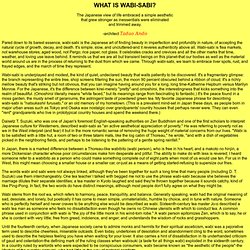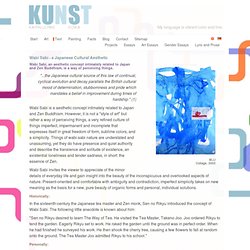

Japanese art. What Is Wabi-Sabi? The Japanese view of life embraced a simple aesthetic that grew stronger as inessentials were eliminatedand trimmed away.

-architect Tadao Ando Pared down to its barest essence, wabi-sabi is the Japanese art of finding beauty in imperfection and profundity in nature, of accepting the natural cycle of growth, decay, and death. It's simple, slow, and uncluttered-and it reveres authenticity above all. Wabi-sabi is flea markets, not warehouse stores; aged wood, not Pergo; rice paper, not glass. It celebrates cracks and crevices and all the other marks that time, weather, and loving use leave behind. Wabi-sabi is underplayed and modest, the kind of quiet, undeclared beauty that waits patiently to be discovered.
Daisetz T. In Japan, there is a marked difference between a Thoreau-like wabibito (wabi person), who is free in his heart, and a makoto no hinjin, a more Dickensian character whose poor circumstances make him desperate and pitiful. Wabi sabi - Learning to See the Invisible. What is wabi sabi?

Ask a Japanese this question and there will likely be a long silence. Pose the same question to an American, however, the answer will often be quick and sure: "It’s beauty of things imperfect! " Why do the Japanese struggle for an answer to the meaning of wabi sabi that seems to come easily to Westerners? Could they be searching for a different answer altogether? "Translation," wrote Kakuzo Okakura, author of the classic The Book of Tea, "can at best be only the reverse side of a brocade, - all the threads are there, but not the subtlety of color or design. " The term wabi sabi is derived from two characters shared by Japanese and Chinese. John-flowers-siuc.pdf (application/pdf Object) Japanese-Aesthetics-and-the-Tale-of-Genji.pdf (application/pdf Object) Book on Line. Murphy_main_study_2008.pdf (application/pdf Object) 2-Prusinkski_001.pdf (application/pdf Object)
The Wabi-Sabi Aesthetic. When I was in school, I fell in love with the same girl twice.

Her name was Frances, and she looked something like Hillary Duff, only with short hair, less eye makeup, and more class. I’m not sure she ever knew I existed. I developed a massive crush on her in eighth grade, followed her around the halls between classes ("She takes English! She must really be smart! "), and never, ever told my friends about her.
Some time during the year, she disappeared — moved away, dad relocated, I didn’t know — and that was it for that, I thought. In my eleventh grade year, she reappeared, and I fell for her again — not realizing it was the same girl I had such a crush on three years before. The thing I remember best about her was her radiant and engaging smile. So, in a sense, this article is all about Frances’s chipped tooth. Wabi-Sabi: Defining the Indefinable Does this idea fall under the rubric of wabi-sabi? "Sen no Rikyu desired to learn The Way of Tea and so visited the Tea Master, Takeno Joo. Wabi, Sabi and Shibui. Japanese Aesthetics_Wabi-Sabi_Tea Ceremony.pdf (application/pdf Object) Wabi Sabi - a Japanese Cultural Aesthetic. BLU Collage, 2003 Wabi Sabi, an aesthetic concept intimately related to Japan and Zen Buddhism, is a way of perceiving things.

"...the Japanese cultural source of this law of continual, cyclical evolution and decay parallels the British cultural mood of determination, stubbornness and pride which mandates a belief in improvement during times of hardship. " (1) Wabi Sabi is a aesthetic concept intimately related to Japan and Zen Buddhism. However, it is not a "style of art" but rather a way of perceiving things, a very refined culture of things imperfect, impermanent and incomplete that expresses itself in great freedom of form, sublime colors, and a simplicity. Things of wabi-sabi nature are understated and unassuming, yet they do have presence and quiet authority and describe the transience and solitude of existence, an existential loneliness and tender sadness, in short: the essence of Zen. Historically: "Sen no Rikyu desired to learn The Way of Tea.
Personally: Book on Wabi Sabi Links: